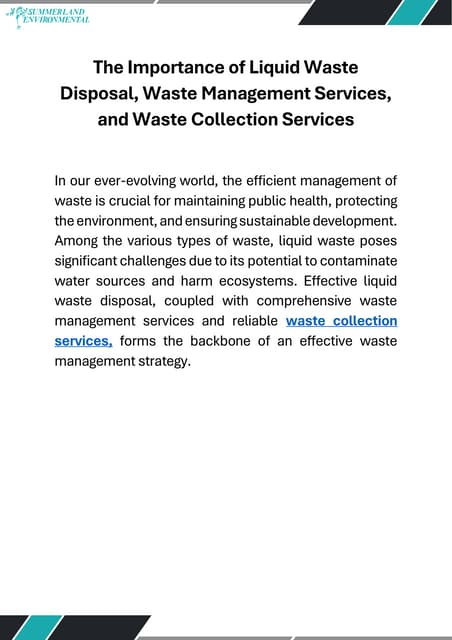6 Easy Facts About Reclaim Waste Described
6 Easy Facts About Reclaim Waste Described
Blog Article
The 20-Second Trick For Reclaim Waste
Table of ContentsOur Reclaim Waste DiariesThe Facts About Reclaim Waste RevealedThe Single Strategy To Use For Reclaim WasteReclaim Waste Fundamentals ExplainedReclaim Waste Things To Know Before You Buy
Discover the kinds, incidents, and forms of fluid waste. Domestic sewer waste refers to the waste and products from a residential septic system. This kind of waste is produced by human beings in homes, schools, and various other buildings. This only consists of sewage-disposal tanks that have a drain area. The proper monitoring and disposal of domestic sewer waste need fluid waste to be moved to a sewer treatment plant where the proper techniques and equipment are put on purify and deal with waste.
Industrial waste often consists of possible hazards, such as flammable products or a mixture of liquid and strong waste items, and requires a much more innovative and in-depth disposal process. The disposal of commercial waste typically includes the filtration of waste before transportation to make certain safe and appropriate disposal. Hazardous waste is developed from byproducts and runoff of industrial procedures and manufacturing.
This sort of waste can not use the exact same sewer monitoring transportation or processes as septic or industrial liquids. The hazardous waste monitoring procedure requires the assessment and screening of liquid waste before it undergoes the disposal process (liquid waste removal). Drainage waste is the fluid waste that originates from drainage and excess stormwater in very booming areas or cities
Runoff waste can trigger contamination and flooding if not managed effectively. Find out more concerning sewage system cleansing and waste management. Making certain correct waste management can avoid catastrophes and decrease environmental harm. Both individuals in domestic setups and experts in industrial or production sectors can profit from recognizing the processes and policies of liquid waste monitoring.
Facts About Reclaim Waste Revealed
Contact PROS Providers today to learn more about our waste administration and disposal solutions and the proper means to care for the fluid waste you produce.
(https://reclaimwaste1.wordpress.com/2024/11/12/efficient-liquid-waste-disposal-in-melbourne-reclaim-wastes-expert-solutions/)Do you recognize what takes place to your water when you disengage, flush the toilet or drain the washing machine? No? Well, it deserves recognizing. This supposed 'wastewater' is not only a vital source however, after therapy, will certainly be released to our land, rivers or the ocean. Used water from commodes, showers, baths, kitchen sinks, washings and industrial processes is called wastewater.

water made use of to cool equipment or tidy plant and equipment). Stormwater, a kind of wastewater, is runoff that moves from agricultural and urban locations such as roof coverings, parks, yards, roads, courses and rain gutters into stormwater drains pipes, after rain. Stormwater flows neglected directly to neighborhood creeks or rivers, ultimately getting to the sea.
The 3-Minute Rule for Reclaim Waste
In Queensland, many wastewater is treated at sewer therapy plants. Wastewater is delivered from domestic or industrial websites through a system of drains and pump terminals, recognized as sewerage reticulation, to a sewage therapy plant. City governments construct, keep and operate most sewage therapy plants. Operators are licensed under the Environmental Management Act 1994 to discharge cured wastewater at an appropriate environmental standard into waterways.
The Division of Natural Resources advises neighborhood governments about managing, operating and preserving sewerage systems and therapy plants. In unsewered locations, local governments may require householders to install individual or home sewage treatment systems to deal with residential wastewater from toilets, cooking areas, restrooms and washings. The Department of Natural Resources authorises the use of household systems when they are proven to be effective.
In some new communities, therapy of some stormwater to eliminate litter, sand and crushed rock has begun making use of gross pollutant catches. Wastewater treatment happens in four phases: Removes strong matter.
Wastewater after that streams right into big containers where solids work out and are gotten rid of as sludge. Grease and residue are skimmed from the surface. Makes use of tiny living microorganisms referred to as micro-organisms to damage down and remove continuing to be dissolved wastes and great particles. Micro-organisms and wastes are included in the sludge. Removes nitrogen and phosphorus nutrients that can trigger algal blossoms in our waterways and intimidate water life.
All about Reclaim Waste
Nutrient elimination is not offered at all sewage therapy plants because it requires pricey specialised equipment. Clear fluid effluent produced after therapy might still have disease-causing micro-organisms - liquid waste removal melbourne.

This normally means wastewater needs to be dealt with or impurities gotten rid of prior to it can be released to rivers. Most wastewater moves right into the sewerage system. Under the Act, local governments carry out authorizations and check this permits for eco pertinent tasks (ERAs) involving wastewater launches that may have a regional impact. The division provides approvals and licences to Periods including wastewater releases that might have a local or statewide effect.
The Single Strategy To Use For Reclaim Waste
Otherwise, examples are considered lab evaluation. Typically many tests are required to develop the levels of each of the various toxins such as oils, heavy metals and chemicals in water. Monitoring gives factual info concerning water quality and can verify that permit problems are being met. The info gotten with tracking gives the basis for making water quality choices.
Report this page